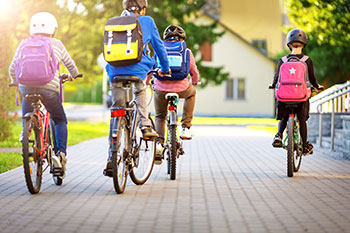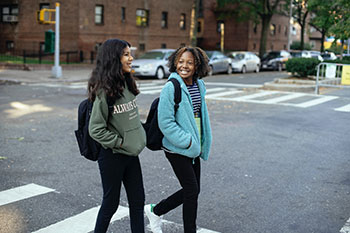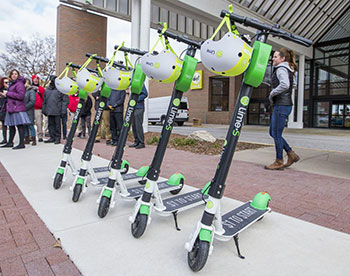Facts & Figures
Bicyclists
In 2019, 846 bicyclists were killed on U.S. roadways and another 4,900 were injured. Although bicyclist deaths have decreased 16% since 1975, they’re up 36% since reaching their lowest point (621) in 2010. Most bicycle-motor vehicle crashes happen in urban settings (70%) and away from an intersection (72%). Although crashes are evenly distributed between daytime and nighttime (47% each), the fact that 80% of bicycle trips take place during the daytime points to the increased risk of riding at night. Male bicyclists are almost six times more likely to be killed than female cyclists. In most bicyclist deaths, the most serious injuries are to the head, highlighting the importance of always wearing an approved and properly fitted bicycle helmet.

Pedestrians
Everyone is a pedestrian. GHSA estimates that 6,721 people on foot were killed on U.S. roads in 2020, up nearly 5% from the year before. Factoring in a significant decline in vehicle miles driven in 2020, the U.S. pedestrian fatality rate rose an unprecedented 21% from 2019 – the largest increase ever recorded. Most pedestrian crashes happen away from intersections and in darkness, pointing to the importance of pedestrian visibility and infrastructure that promotes safe crossings. Larger vehicles also pose a significant threat to people on foot. Although passenger cars are more likely to be involved in fatal pedestrian crashes, from 2010 to 2019 the number of pedestrian fatalities involving SUVs increased at a faster rate compared to passenger cars – 69% versus 46%.

Electric Scooters (E-scooters)
E-scooters, which began appearing virtually overnight on city streets in 2018, are soaring in popularity as people look for fun, convenient and healthy ways to get around while following social distancing guidelines. In 2019, people took 88 million trips on e-scooters – more than double the 38.5 million e-scooter trips the year before. While many people are familiar with riding a bicycle, far fewer are experienced e-scooter riders. Most scooter injuries are the result of falls or the rider having difficulty navigating around objects such as light poles or uneven sidewalks. Head injuries are a top concern for e-scooter riders. A study of riders involved in crashes in Austin, Texas found that 45% of e-scooter crashes involved head injuries, with 15% suffering traumatic brain injuries. Less than 1% of the riders were wearing a helmet.

Safety Best Practices
Always wear a helmet while riding a bicycle or e-scooter.
- Your helmet should sit straight on your head, one to two inches above your eyebrows, and be secured tightly with a chin strap.
- If you’re using a bike-share or e-scooter, bring your helmet when you leave home.
- Never use a helmet that was worn during a crash, even if it was minor.
- Check if your helmet is certificated for bicycle riding on the Consumer Product Safety Commission website.
- NOTE: There are different helmet standards for e-scooters that travel more than 20 mph and for bicycles.
Be visible at all times.
- Wear bright colored (preferably reflective) clothing, especially at night.
- If on a bike or an e-scooter, check to make sure the front and rear lights and reflectors work properly before your trip.
- If you’re walking after dark, bring a flashlight.
Keep your eyes on the road or sidewalk, not your phone.
- That trending TikTok video or group text message can wait. Getting likes or cracking jokes with friends isn’t worth risking your life.
- On a bike or e-scooter, keep your hands on the handlebars at all times.
- If you must use a phone for GPS directions on a bike or scooter, mount it securely in the middle of your handlebars. Avoid holding it in your hand or pulling it out of your pocket while riding.
Ride a bicycle or e-scooter predictably so others on the road know what you’re going to do.
- Obey all traffic signals, signs and laws.
- Signal all turns using the e-scooter’s signals or standard hand signals.
- Use bike lanes where available so you’re keeping the sidewalk clear for pedestrians. If you must ride on the sidewalk, always give pedestrians the right of way and slow down.
- If you have to use the road, always ride with traffic.
More Tips for Bicyclists
Ride a bike that fits you correctly.
- You should be able to dismount and stand over your bike comfortably, have full leg extension when pedaling and be able to touch the ground with your feet.
Conduct an A-B-C check before every ride.
- Air pressure: Pinch the tires to ensure they’re properly inflated.
- Brakes: Test that the front and rear brakes work.
- Chain: Spin the pedals to make sure your chain is properly attached.
- If your bike fails any of these tests, fix the problem before you go for a ride.
More Tips for Pedestrians
Always use a sidewalk, if available.
- If a sidewalk isn’t an option, walk facing traffic to better see approaching vehicles.
Look both ways before crossing the street.
- Unfortunately, drivers sometimes run red lights and don’t stop at stop signs, even though it’s the law.
- Always check traffic to ensure no vehicles are coming toward you – even if you have the right of way.
Only cross in crosswalks and at intersections.
- Drivers are not accustomed to watching out for pedestrians in areas other than crosswalks and intersections.
Wait for the pedestrian walk signal, if there is one.
More Tips for E-scooters
Participate in a “learn to ride” event.
- These events can teach you basic functions and safety best practices for e-scooters available in your area.
- If an in-person event isn’t available, review the safety tips on provider apps and websites.
